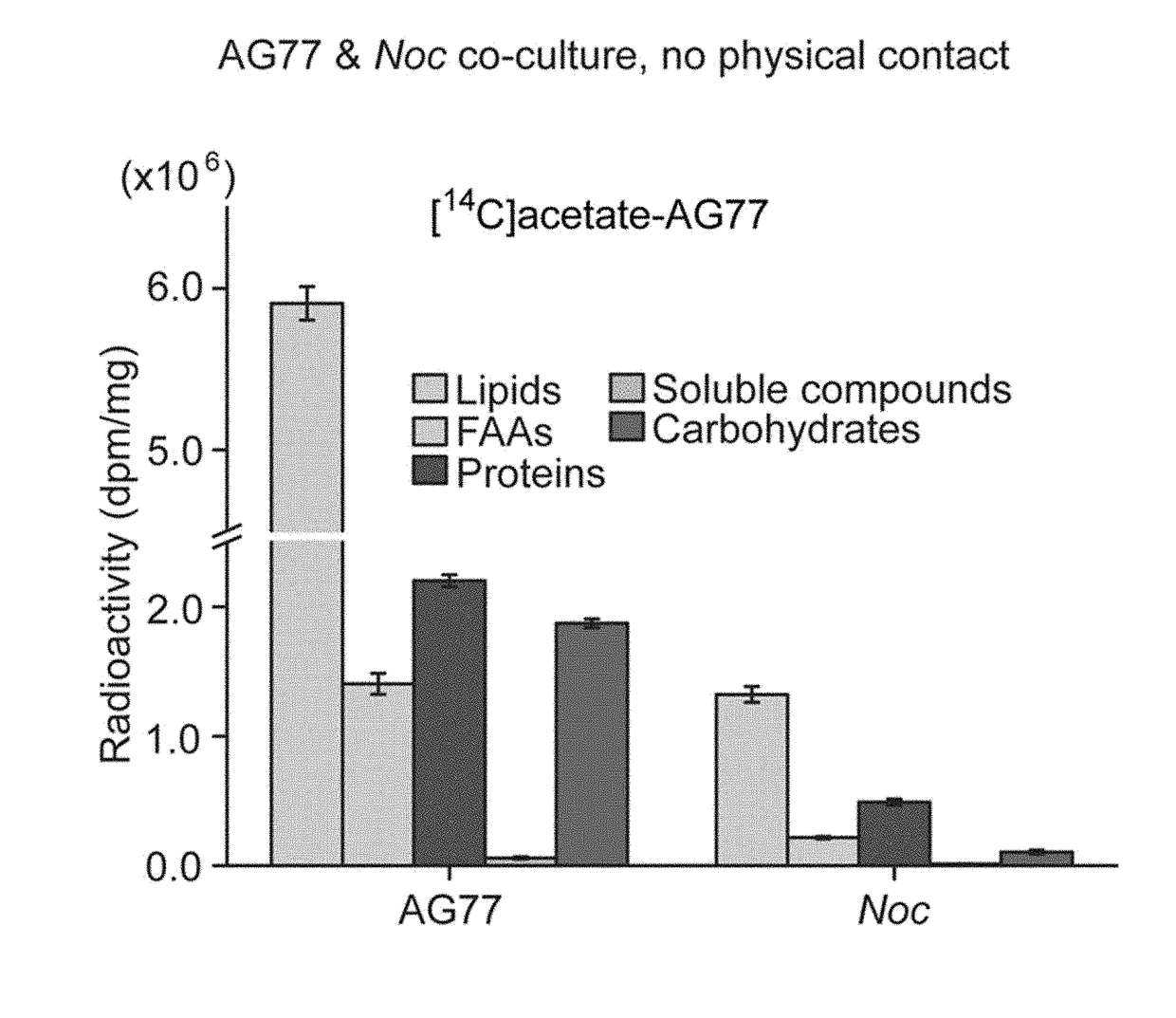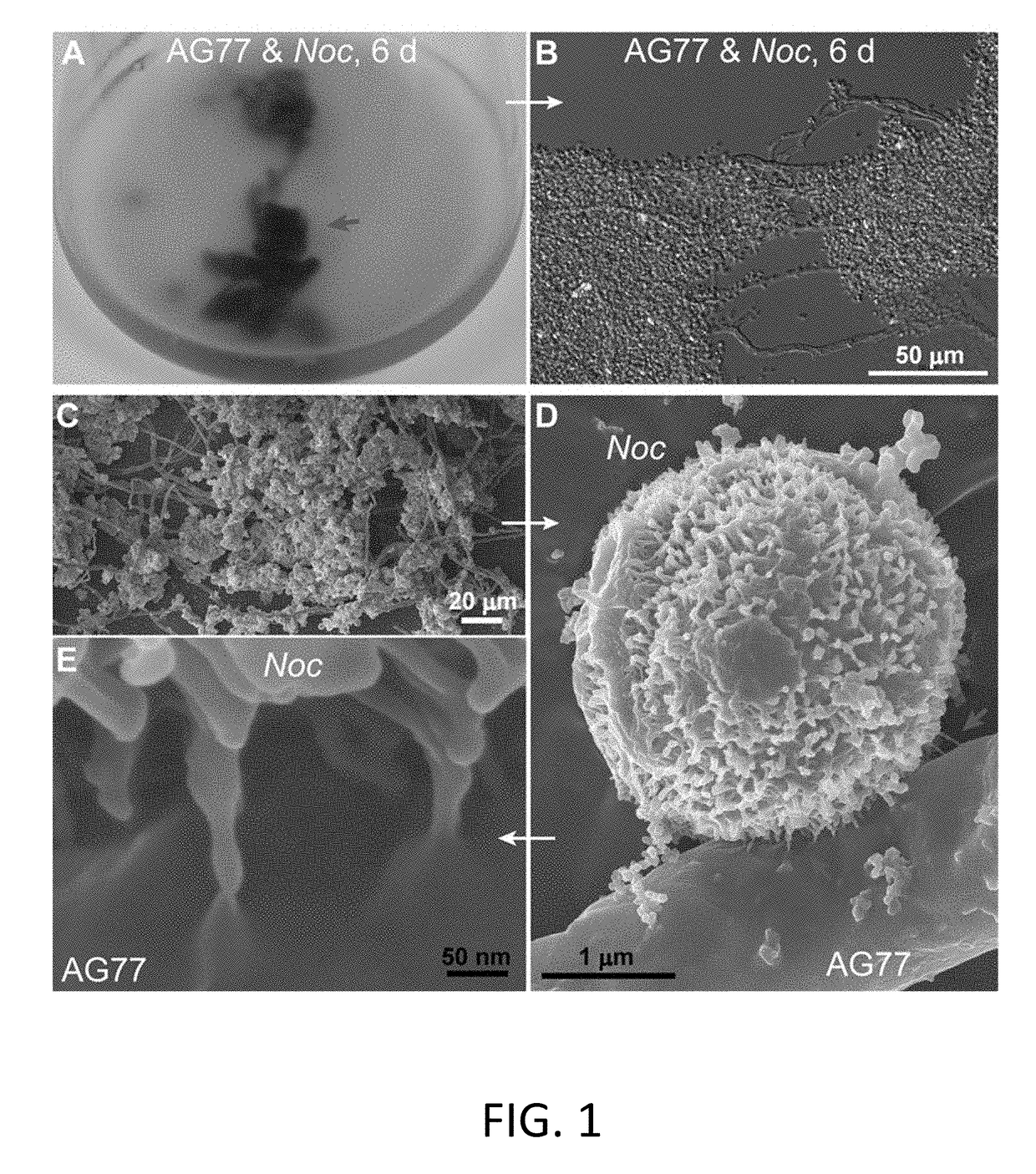Lipid biosynthesis and abiotic stress resilience in hotosynthetic organisms
a technology of lipid biosynthesis and abiotic stress resilience, which is applied in the direction of biochemistry apparatus and processes, microorganisms, fungi based processes, etc., can solve the problems of low market price of energy and fuel, depletion of accessible petroleum and natural gas deposits, and inability to produce fuels using food crops. optimal in the long term, to achieve the effect of facilitating the formation of consortiums
- Summary
- Abstract
- Description
- Claims
- Application Information
AI Technical Summary
Benefits of technology
Problems solved by technology
Method used
Image
Examples
example 1
and Methods
[0039]This Example describes some of the materials and methods that were used in the development of the invention.
Strains and Growth Conditions
[0040]Marine alga Nannochloropsis oceanica CCMP1779 was obtained from Provasoli-Guillard National Center for Culture of Marine Phytoplankton and incubated as described by Vieler et al. (PLoS Genet. 8, e1003064 (2012)). In brief, N. oceanica cells were grown in flasks containing f / 2 media under continuous light (˜80 μmol / m2 / s) at 22° C. with agitation (100 rpm). Log-phase algal culture (1-3×107 cells / mL) was used for co-culture with fungi. Cell size and density of algal culture were determined using a Z2 Coulter Counter (Beckman). Mortierella elongata AG77 and NVP64 were isolated from soil samples collected at North Carolina, USA (AG77) and Michigan, USA (NVP64). M. elongata AG77 and NVP64 hosting bacterial endosymbiont had been cured of their endobacteria by a series of antibiotic treatments as described by Partida-Martinez et al. ...
example 2
or Evaluating Nutrient Exchange Between Fungi and Algae
[0048]Light microscopy and SEM showed tight physical interaction between soil fungus Mortierella elongata and the marine algae Nannochloropsis oceanica. This Example describes experiment procedures for evaluating whether metabolic exchanges occur between N. oceanica and M. elongata.
[0049]Isotope labeling and chasing experiments were performed using labeled carbon and nitrogen (14C and 15N) nutrients for N. oceanica and M. elongata. For 14C assays, 20 μL of [14C]sodium bicarbonate (1 mCi / mL, 56 mCi / mmol, American Radiolabeled Chemicals) was added to 20 mL of early log-phase culture of N. oceanica (˜2×106 cells / mL) and incubated for 5 days when the 14C incorporation reached ˜40%. The 14C-labeled N. oceanica cells were harvested by centrifugation (4,000 g for 10 min) and washed three times with f / 2 medium. The supernatant of the last wash was analyzed in Bio-Safe II counting cocktail (Research Products International) using a scint...
example 3
trient Exchange Between Fungi and Algae
[0056]To test whether carbon or nitrogen exchange underlies the interaction between the soil fungus Mortierella elongata AG77 and the marine algae Nannochloropsis oceanica, a series of experiments were conducted using reciprocally 14C- and 15N-labeled algal and fungal partners. For carbon exchange assays algal cells were labeled with [14C]-sodium bicarbonate and co-cultivated with non-labeled hyphae in flasks for one week. Conversely, fungal hyphae were grown in either [14C]-glucose- or [14C]-acetate-containing medium, then were co-incubated with non-labeled algal cells in flasks that allowed the two organisms to interact physically. Co-cultured algal and fungal cells were separated from each other by mesh filtration and were then analyzed for 14C exchange.
[0057]FIG. 2A-1 shows that 14C-carbon is transferred from the alga (Nannochloropsis oceanica; Noc) to the fungus (Mortierella elongata AG77). Nearly 70% of the transferred 14C-carbon was inco...
PUM
| Property | Measurement | Unit |
|---|---|---|
| pore size | aaaaa | aaaaa |
| pore size | aaaaa | aaaaa |
| pore size | aaaaa | aaaaa |
Abstract
Description
Claims
Application Information
 Login to View More
Login to View More - R&D
- Intellectual Property
- Life Sciences
- Materials
- Tech Scout
- Unparalleled Data Quality
- Higher Quality Content
- 60% Fewer Hallucinations
Browse by: Latest US Patents, China's latest patents, Technical Efficacy Thesaurus, Application Domain, Technology Topic, Popular Technical Reports.
© 2025 PatSnap. All rights reserved.Legal|Privacy policy|Modern Slavery Act Transparency Statement|Sitemap|About US| Contact US: help@patsnap.com



